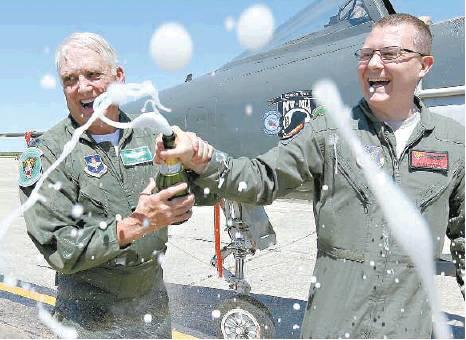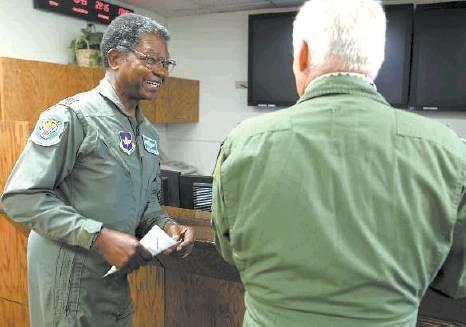| I
was watching the NBC local news in San Antonio when our own Tony
Marshall appeared on the screen. Seems Randolph was honoring two
Vietnam POWs, Jack Trimble (70) and Tony. See the attached article
from the paper.
I have to
say Tony looks really good, very distinguished, very articulate,
and appears much younger than the rest of us. He even looked really
good in a flight suit and G-suit. How many of us could do that.
Ron Jackson
|
Vietnam aviators receive a salute
Ex-weapons officers are first to get ‘fini flight’ honor
By Sig Christenson STAFF WRITER
America’s Vietnam prisoners of war
Of the 58,220 troops who died in the war, 3,000 were
aviators. The United States brought home 684 prisoners of war, all but
about 54 of them military. Forty-six died in captivity.

Jack Trimble (left), who was shot down during the Vietnam War and
became a prisoner of war, is sprayed with champagne by Maj. Ryan
Troxel after Trimble completed his “fini flight” with
the 560th Flight Training Squadron.
|

Like his friend
Trimble, Tony Marshall was a weapons officers when his aircraft
went down during the Vietnam War. Later, after being freed as POWs,
Marshall and Trimble both earned their pilots’ wings. |
PRISONERS RELEASED
Air Force — 332 Army — 121 Navy — 149 Marine Corps —
28 Civilians — 54*
PRISONERS DYING IN CAPTIVITY
Air Force — 16 Army — 10 Navy — 11 Marines — 6 Civilians
— 3* * The Defense Department has said 54 U.S. civilians were captured
in the war, but the number could be off by two. Source: U.S. Air Force
The morning he flew his 266th mission over Vietnam, Air Force Capt.
Tony Marshall only knew the pilot in the seat in front of him, Capt.
Steve Cuthbert, by reputation. Tall and thin with a shock of sandy blond
hair, Cuthbert never suffered a lack of confidence flying the F-4 Phantom.
“He told me he would never be captured when shot down,” Capt.
Ross Detwiler, another pilot, later wrote, recalling a conversation
the night before a malfunction sent Cuthbert’s plane to the ground
in 1972.
Cuthbert was believed killed after capture, and Marshall, his weapon
systems officer who handled the fighter-bomber’s air-to-air missiles
and other ordnance, became a prisoner of war.
Decades later, Marshall and an old friend, retired Lt. Col. Jack Trimble,
a fellow POW shot down in a separate incident, were at Joint Base San
Antonio-Randolph on Thursday for the 44th annual Freedom Flyer Reunion,
which solemnly salutes the return of 684 American prisoners from Vietnam
in 1973, almost half of them airmen.
Their memories rushed back this week as they took in a preflight briefing
in standard-issue flight suits, carrying helmets and making a bit of
Air Force history as the 197th and 198th “Freedom Flights”
given by the 560th Flying Training Squadron.
On Thursday, they became the first weapons officers captured in Vietnam
to get a “fini flight” — a final, celebratory mission
capping their aviation careers.
Before them, only pilots had been given that honor. The two would earn
their wings after being freed, but when they were based at Udorn Royal
Thai Air Base in Thailand in the 13th Tactical Fighter Squadron, they
flew in the back seats of the F-4.
As Cuthbert and Marshall flew fast and low over North Vietnam on July
3, 1972, a fuel tank’s nose cowling came off, and Cuthbert had
to jettison the cockpit canopy with a sudden blast. Without the cone,
the drag of the empty fuel tank under the plane made the F-4 pitch uncontrollably.
At a higher altitude, Cuthbert might have recovered, but at just 3,500
feet, there was no chance.
Marshall and Cuthbert were blown out of the jet, stunned but conscious
after hitting the wind at 633 mph. Marshall landed on a hillside and
stood up, part of his parachute over one shoulder and Phantoms racing
past him, sometimes lower than 1,000 feet.
The noise was deafening.
“And then the next thing I remember is this out-of-body experience
where I’m watching an idiot stand there with a radio in his hand,”
Marshall 70, of Apple Valley California, recalled, chuckling. “Obviously,
it’s me.”
A half-dozen armed Vietnamese surrounded him and gestured excitedly.
Marshall, in shock, didn’t know what they wanted. They took his
survival vest, handgun and flight suit, some of them playing with its
zippers before binding him and moving him to an underground bunker.
A man later came down with a flashlight, prompting Marshall to think,
“They’re going to shoot me now,” he said.
Trimble was making his 186th combat mission and his 99th over Hanoi,
escorting Air Force A-7s when the Phantom crews engaged a MiG-21 on
Dec. 27, 1972. As he and Maj. Carl Jefcoat headed back to Thailand,
they didn’t see the one that came at them from behind.
“It was a loud bang and whoosh! I had to get ahold of my ejection
handle and out I went,” said Trimble, 69, of Memphis, Tennessee.
“The chute opened up and I looked down and saw below me quite a
ways, and I saw my airplane hit and explode, and then I looked around
to see if I could see the other pilot, and I couldn’t.”
Just as worrisome was where he was headed — straight into the trees.
He slipped through the foliage and found himself just a foot above the
ground, immediately grasping his good fortune. He wasn’t wounded.
Jefcoat, too, survived the crash and captivity. He died in 1987.
Trimble hid, but had no hope of escaping and was in enemy hands two
hours later. A militiaman tried to incite a crowd of civilians that
had gathered around him.
“He pointed at me and yelled at them and pointed at me, and turned
around and hit me in the face. And I could see it coming. My hands were
tied behind, and I just rolled my head and I felt the blow, but it didn’t
hurt,” Trimble said.
“So he hit me and the response from the crowd was electric. And
this guy said a few things and started hitting me again and an old man
came out of the crowd and grabbed his arm and just chewed him out. He
lost great face in front of them.”
Trimble and Marshall had brief stints in the infamous Hanoi Hilton,
but quickly were moved to Cu Loc prison, an old French film processing
plant called “the zoo.” They never saw each other there but
both recalled living on a daily cup of gruel-like cabbage soup, a single,
late-afternoon meal occasionally topped with stale, moldy French bread.
“It was entertainment,” Marshall said of the bread, which
had bugs cooked in it. “Sesame seeds, with legs on them.”
The events at Randolph will culminate with a wreath-laying ceremony
at 10:15 a.m. today at its Missing Man monument, followed by a flyover
— an F-16 Fighting Falcon, T-38C Talon, T-1A Jayhawk, T-6A Texan
II, T-34 Mentor and a U-28A, a surveillance aircraft used to support
Special Operations troops.
A symposium featuring five former POWs is set for at 1 p.m. in Fleenor
Auditorium.
Marshall and Trimble were released on March 29, 1973 and flown to Clark
Air Base in the Philippines, then home. Both earned their pilots’
wings together at Williams AFB in Phoenix and spent another two decades
in the Air Force, retiring as lieutenant colonels before landing commercial
airline jobs.
Trimble and his wife, Rachel, marked the 40th anniversary of his capture
by meeting the North Vietnamese pilot who shot him down. Tran Viet,
a retired brigadier general in Vietnam’s air force, was perhaps
27 on that day of battle. Trimble was 25.
“I certainly had been in engagements and killed his friends, and
vice versa,” Trimble said, calling the visit a great experience.
“War is war. You respect the soldiers.”
Marshall began his stint as a POW by telling his captors a string of
contradictory stories in hopes of confusing them. One of the tales was
claiming to be a married man.
“Here I am, it’s graduate school for survival,” he said.
“What can I get away with? So I just started seeing what lies I
could tell. … Over the next two weeks I invented a half-dozen new
girlfriends because they were fascinated by girlfriends. I got bored
with that and created a wife and a kid. When they released me, they
walked in and handed me my wedding ring.”
It turned out to be Cuthbert’s.
sigc@express-news.net - News Researcher Mike Knoop contributed to this
report.
